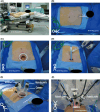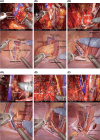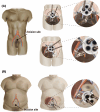Extraperitoneal single-site robot-assisted radical prostatectomy with extended pelvic lymph node dissection: technique and experience
- PMID: 39887625
- PMCID: PMC11913595
- DOI: 10.1111/bju.16670
Extraperitoneal single-site robot-assisted radical prostatectomy with extended pelvic lymph node dissection: technique and experience
Keywords: Lymphocele; extended pelvic lymph node dissection; locally advanced prostate cancer; robot‐assisted radical prostatectomy; single site.
Figures



Similar articles
-
Lymphocele after extraperitoneal robot-assisted radical prostatectomy: a propensity score-matching study.Int J Urol. 2013 Dec;20(12):1169-76. doi: 10.1111/iju.12144. Epub 2013 Mar 21. Int J Urol. 2013. PMID: 23521086
-
The deep vein thrombosis caused by lymphocele after endoscopic extraperitoneal radical prostatectomy and pelvic lymph node dissection.Can Urol Assoc J. 2011 Jun;5(3):E40-3. doi: 10.5489/cuaj.10093. Can Urol Assoc J. 2011. PMID: 21672491 Free PMC article.
-
Standardized comparison of robot-assisted limited and extended pelvic lymphadenectomy for prostate cancer.BJU Int. 2013 Jul;112(1):81-8. doi: 10.1111/j.1464-410X.2012.11788.x. Epub 2013 Jan 25. BJU Int. 2013. PMID: 23351148
-
Role of robot-assisted radical prostatectomy in locally advanced prostate cancer.Int J Urol. 2018 Jan;25(1):30-35. doi: 10.1111/iju.13441. Epub 2017 Sep 13. Int J Urol. 2018. PMID: 28901630 Review.
-
Robot-Assisted Treatment of Symptomatic Lymphocele Postradical Prostatectomy and Lymphadenectomy in the Era or Robotic Surgery: Narrative Review.Technol Cancer Res Treat. 2023 Jan-Dec;22:15330338221145248. doi: 10.1177/15330338221145248. Technol Cancer Res Treat. 2023. PMID: 37350154 Free PMC article. Review.
References
-
- Cornford P, Van Den Bergh RCN, Briers E et al. EAU‐EANM‐ESTRO‐ESUR‐ISUP‐SIOG guidelines on prostate cancer—2024 update. Part I: screening, diagnosis, and local treatment with curative intent. Eur Urol 2024; 86: 148–163 - PubMed
-
- Kaouk J, Aminsharifi A, Wilson CA et al. Extraperitoneal versus transperitoneal single port robotic radical prostatectomy: a comparative analysis of perioperative outcomes. J Urol 2020; 203: 1135–1140 - PubMed
-
- Lenfant L, Sawczyn G, Aminsharifi A et al. Pure single‐site robot‐assisted radical prostatectomy using single‐port versus multiport robotic radical prostatectomy: a single‐institution comparative study. Eur Urol Focus 2021; 7: 964–972 - PubMed
-
- Ploussard G, Briganti A, De La Taille A et al. Pelvic lymph node dissection during robot‐assisted radical prostatectomy: efficacy, limitations, and complications—a systematic review of the literature. Eur Urol 2014; 65: 7–16 - PubMed
Grants and funding
LinkOut - more resources
Full Text Sources

